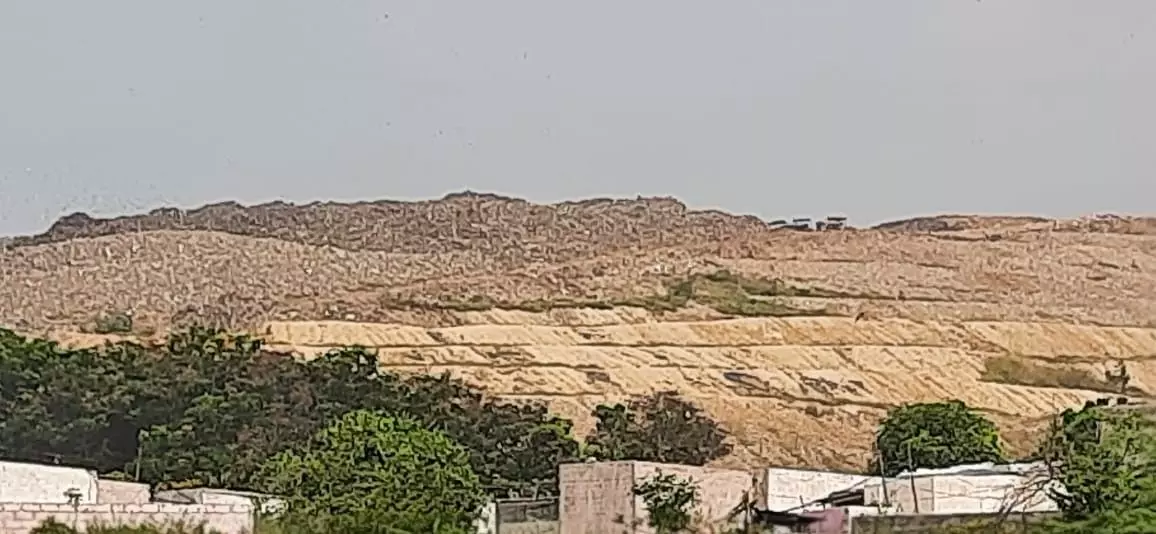
Hyderabad Jawahar Nagar: How years of activism and fight forced action on landfill disaster
For residents who live close by, the NGT order brings long-awaited relief

The National Green Tribunal (NGT) has finally taken decisive action on the long-standing garbage crisis at Jawahar Nagar, which has plagued Hyderabad and its surrounding areas for nearly three decades.
The Federal Telangana has published a series of reports highlighting the environmental and health toll of the Jawahar Nagar yard. The coverage documented how toxic leachate from the landfill polluted air, groundwater, and nearby ponds, affecting at least 12 surrounding villages.
Also Read : How residents of Jawahar Nagar, Hyderabad's garbage dump, are living with health woes
Acting on the orders of Justice Pushpa Satyanarayana of the NGT’s Southern Zone in Chennai, the Telangana government has been directed to immediately halt the dumping of new garbage and refuse-derived fuel (RDF) at the site. For residents who have lived amid foul odours, contaminated groundwater, and persistent disease outbreaks, the order marks a long-awaited victory.
A major order after years of activism
The NGT’s directive follows years of legal battles and protests by local residents. The Anti-Dumping Yard Joint Action Committee (JAC), led by co-convener Kethepalli Padmachari, has been at the forefront of the movement since 2021, when the group, along with activists B Sankaranarayanan, A Sanjeevareddy Balakrishna, and 15 others, filed a petition before the tribunal.
The petition sought the relocation of the Jawahar Nagar dumping yard and relief for nearby villages suffering from severe pollution. “This order is the result of our four-year struggle,” Padmachari told Federal Telangana.
Pakalapati Srilesh Sandeep, president of the Karmika Nagar Navodaya Welfare Society, added that the community has been waging this battle for over a decade. The Federal has been covering the issue for a long time and special stories with titles such as Telangana town drowning in dirt and Pollution eating away at Jawahar Nagar were amplified across social media and community networks.
These reports were also shared with the Greater Hyderabad Municipal Corporation (GHMC) Commissioner and submitted as evidence to the NGT.
CPCB-IIT Bombay report on pollution
Earlier, the NGT had directed the Central Pollution Control Board (CPCB) to consult with GHMC officials and experts from IIT Bombay to find long-term solutions. Following this, a CPCB-led review meeting was held on October 10, 2025, and a detailed report was submitted by the IIT Bombay expert team on October 28.
Also Read: Hyderabad’s garbage capital: Jawahar Nagar’s 27-year struggle for clean air
The report confirmed that GHMC’s waste management practices were contributing to air and groundwater pollution, and recommended that the civic body bear the cost of remediation. The report also included findings from the Telangana State Pollution Control Board and CPCB’s Chennai Regional Office.
Search for alternatives
In response to the NGT’s directive, GHMC officials have begun discussions on alternative dumping sites across Hyderabad. Earlier plans to establish landfills in Pyaranagar, Dundigal, Kothur, Lakdaram, and Shadnagar were scrapped after local opposition and court interventions.
Environmental activist Gogula Ramakrishna from the Jawahar Nagar Dumping Yard Removal People’s Forum noted that despite regulations prohibiting garbage disposal within 3 to 5 km of the Outer Ring Road, the government had earmarked land just 1.7 km away, a plan that also fell through amid protests.
Experts demand stricter enforcement
Chennai-based researcher DK Chaitanya of the Centre for Financial Accountability has called for stricter classification of waste-to-energy plants under the "red category" of the CPCB norms to curb emissions. He emphasised the need to prevent plastic burning, which he said contributes to a pollution index of 97.6.
Also Read: Bengaluru civic body dumps garbage back at households: Optics or accountability?
Hyderabad environmentalist Ruchit Ashakumar, spokesperson of Climate Front, told Federal Telangana that the dumping yard’s waste-to-energy unit fails to meet national standards. He added that plastic burning and improper ash disposal continue unchecked, worsening air and water pollution.
A fact-finding committee of ten environmentalists found that GHMC had also ignored the mandatory creation of a green belt, worker zones, and tree plantations around the facility.
A test of implementation
While the NGT’s order represents a breakthrough in environmental justice for Hyderabad, the real test lies in its implementation. Effective enforcement will require coordination between GHMC, the Pollution Control Boards, and the state government.
After decades of neglect, the people of Jawahar Nagar are finally seeing hope, but lasting change will come only when waste management replaces waste dumping as the city’s guiding principle.
(This article was originally published in The Federal Telangana.)

